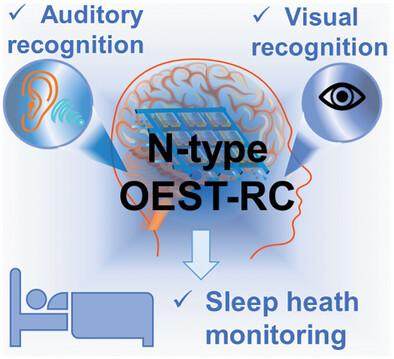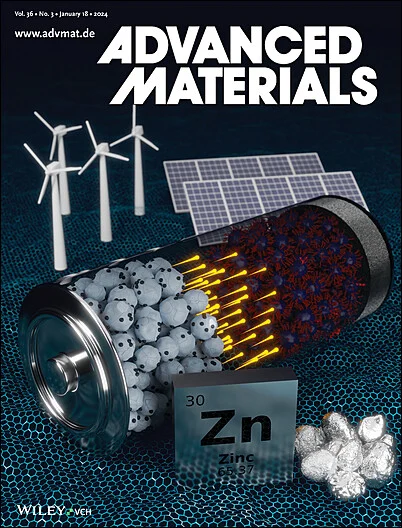通过水库计算实现硬件可行且高效的 N 型有机神经形态信号识别
IF 27.4
1区 材料科学
Q1 CHEMISTRY, MULTIDISCIPLINARY
引用次数: 0
摘要
受生物神经系统的启发,有机电化学突触晶体管(OESTs)因其在神经形态计算中的多功能应用而受到越来越多的关注。然而,用于信号识别的有机突触晶体管的实际应用,尤其是那些利用 n 型有机混合离子电子导体(OMIEC)的有机突触晶体管,在硬件层面仍然面临着巨大的挑战。本文介绍了一种最先进的小分子 n 型 OEST,它集成在物理上简单、硬件上可行的储层计算(RC)框架中,可用于实际的时间信号识别。这种集成是通过利用 n-OEST 的可调突触特性实现的,n-OEST 表现出可调非线性短时记忆,从波动性过渡到非波动性,并显示出自适应的时间特异性。此外,非挥发性 OEST 在长期电位/抑制(LTP/LTD)方面提供了 256 个电导水平和宽动态范围(≈147),超过了之前报道的 n-OEST。通过将易失性 n-OEST 作为储存器与由非易失性 n-OEST 网络组成的单层感知器读出器相结合,该物理 RC 系统实现了对手写数字图像(94.9%)和口语数字(90.7%)的高识别准确率,以及超高的权重效率。此外,该系统在实际睡眠监测,特别是鼾声识别方面,通过分组 RC 实现了出色的准确率(98.0%)。在此,我们提出了一条可靠的 OMIEC 驱动计算途径,以推动物理世界中基于生物启发硬件的神经形态计算。本文章由计算机程序翻译,如有差异,请以英文原文为准。

Hardware-Feasible and Efficient N-Type Organic Neuromorphic Signal Recognition via Reservoir Computing
Organic electrochemical synaptic transistors (OESTs), inspired by the biological nervous system, have garnered increasing attention due to their multifunctional applications in neuromorphic computing. However, the practical implementation of OESTs for signal recognition—particularly those utilizing n-type organic mixed ionic-electronic conductors (OMIECs)—still faces significant challenges at the hardware level. Here, a state-of-the-art small-molecule n-type OEST integrated within a physically simple and hardware feasible reservoir-computing (RC) framework for practical temporal signal recognition is presented. This integration is achieved by leveraging the adjustable synaptic properties of the n-OEST, which exhibits tunable nonlinear short-term memory, transitioning from volatility to nonvolatility, and demonstrating adaptive temporal specificity. Additionally, the nonvolatile OEST offers 256 conductance levels and a wide dynamic range (≈147) in long-term potentiation/depression (LTP/LTD), surpassing previously reported n-OESTs. By combining volatile n-OESTs as reservoirs with a single-layer perceptron readout composed of nonvolatile n-OEST networks, this physical RC system achieves substantial recognition accuracy for both handwritten-digit images (94.9%) and spoken digit (90.7%), along with ultrahigh weight efficiency. Furthermore, this system demonstrates outstanding accuracy (98.0%) by grouped RC in practical sleep monitoring, specifically in snoring recognition. Here, a reliable pathway for OMIEC-driven computing is presented to advance bioinspired hardware-based neuromorphic computing in the physical world.
求助全文
通过发布文献求助,成功后即可免费获取论文全文。
去求助
来源期刊

Advanced Materials
工程技术-材料科学:综合
CiteScore
43.00
自引率
4.10%
发文量
2182
审稿时长
2 months
期刊介绍:
Advanced Materials, one of the world's most prestigious journals and the foundation of the Advanced portfolio, is the home of choice for best-in-class materials science for more than 30 years. Following this fast-growing and interdisciplinary field, we are considering and publishing the most important discoveries on any and all materials from materials scientists, chemists, physicists, engineers as well as health and life scientists and bringing you the latest results and trends in modern materials-related research every week.
 求助内容:
求助内容: 应助结果提醒方式:
应助结果提醒方式:


